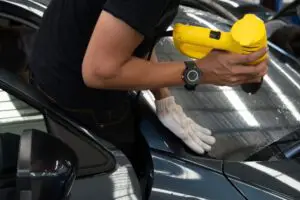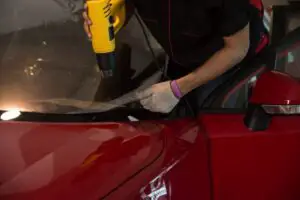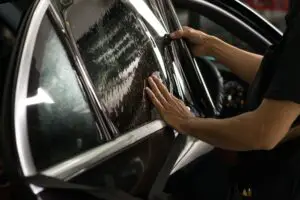Window tinting laws demonstrate how much light should be permitted inside the vehicle, how dark it can be and how reflective the windows can be.
When it comes to tinting the windows of your vehicle, you must know that these laws exist so you can drive safely at the same time, given the privacy you need.
It depends on the type of vehicle you own, so you must read the laws and follow them accordingly.
Maryland window tint laws say that the windshield must use non-reflective tint with 35% of VLT permitted on the AS-1 line.
It can also be only done on the top five inches of the windshield. When it comes to other windows, the laws are different, so read this article to find out more.
There is a lot to learn related to the window tinting laws in Maryland, which you will be able to find out in more detail if you read this article very carefully and to the end.
It will also help you better understand, so make sure to read them as well. I have also included some frequently asked questions, so you do not have to search for them anywhere else.
Table of Contents
- 1 How Much Tint Darkness Is Legal In Maryland?
- 2 Window Tint Reflection And Tint Colors
- 3 Medical Exemption Of Window Tint Laws In Maryland
- 4 Get A Certified Sticker From The Company
- 5 Other Window Tint Law Rules And Regulations In Maryland
- 6 Cost Of Car Window Tint In Maryland
- 7 Frequently Asked Questions
- 8 Conclusion
How Much Tint Darkness Is Legal In Maryland?

When it comes to tinting darkness in Maryland, you must keep in mind that determining how dark the tint can be is firstly measured by VLT, also known as Visible Light Transmission, in percentage.
This will help you understand how much light is allowed to enter by combining two factors; the window film and the window glass.
Besides that, keep in mind that the lower the percentage, the darker the window tint will be.
Now I will be discussing the tint darkness allowed for passengers and multipurpose vehicles. If you own either of the two, this will help you decide.
Tint Darkness Limit For SUVs And Vans
The SUVs in Maryland must use non-reflective tints on the front windshield.
You must also know that it should either be on the AS-1 line or it can be on the top five inches of the windshield. It should also allow around 35 percent of light inside the vehicle.
Moving on to the front seat side windows of the SUVs, you should know that 35 percent of light or more than that should be coming inside the vehicle through the windows.
Lastly, the back seat side windows and the rear windows of the SUVs have no limitations, which mean that they can go on any dark level for the windows.
Tint Darkness Limit For Sedans
For sedans in Maryland, the tint darkness limit is said to be different, so if you own one, you should know about this before deciding on tinting.
1. Front Windshield
On the other hand, the front windshield must use non-reflective tint, and it should also be more than 35 percent. It can be on the AS-1 like or on the top five inches of the windshield.
2. Front Seat Side Windows
The front-seat side windows for sedans must let 35 percent visible light transmission or more than that through the windows, it cannot be less than that.
3. Rear Window
The rear windows for sedans should allow more than 35 percent VLT of light inside the vehicle.
4. Back Seat Side Windows
Lastly, the back seat side windows should be the same as the rear windows of sedans. It should allow more than 35 percent light. Make sure it is not less than that at all.
Window Tint Reflection And Tint Colors
- While the amount of tint varies from automobile to automobile, Maryland’s restrictions on reflecting tint are far more uniform or won’t be difficult for you to understand but just be sure to follow them at all times.
- The front-seat side windows for sedans, SUVs, and vans should not use metallic or mirrored finish at all. This also applies to the back seat side windows of all these vehicles.
- When you decide on tinting, make sure that you avoid the colors red, yellow, and amber, as they are said to be illegal in Maryland.
Medical Exemption Of Window Tint Laws In Maryland

If you have a medical problem that prohibits you from being exposed to the sun, for example, if you have photophobia or any situation that might dissuade you from being exposed to the sun, you may be excused from the tint limits.
However, because you will probably get pulled over for a tint infraction, you will be required to keep proof of your medical exemption in the vehicle with you all the time to show it to the police officers if there is ever a need for it.
Get A Certified Sticker From The Company
Although a label to signify lawful tinting is said to be not required by the Maryland constitution, it is still worth mentioning that it is advised that each tinted window of your vehicle have a sticker between the film as well as the glass.
It will be best for you to still place the stickers on the vehicle so you do not have potential problems, especially if you have been medically exempt, since there are more chances of getting pulled over if you have darker tints due to medical conditions.
Other Window Tint Law Rules And Regulations In Maryland
Since most of the primary regulations have been covered, there are still a couple of aspects of Maryland’s automobile window tint rules that need to be covered for you to have a promising grasp of the law.
- Vehicles that have rear windows tinted are required to use dual side mirrors.
- The producers of the film must produce reliable and certified films. Make sure the film has been certified by the state of Maryland before purchasing.
- You can use stickers so they can be identified as legal tinting. Make sure to place the stickers in the middle of the window film and the window glass.
- Windshield tints less than 5 inches and tinted brake and headlights are said to be severely forbidden.
- You are not allowed to use the colors red, amber, and yellow in the state of Maryland, so make sure to avoid them.
Well, there you have it, all the additional rules and regulations.
It is also worth mentioning that obtaining the county protocol on tinted windows by visiting your regional police headquarters can guarantee that you adhere to the guidelines.
Cost Of Car Window Tint In Maryland
Coming over to the cost of an automobile window tint in the state of Maryland, keep in mind that it can vary depending on what time you are looking for, how many windows you are getting tinted, and the window tint warranty.
However, if you plan on getting a typical film for a sedan vehicle, then it can cost around $150.
But if you use a different quality product, such as the ceramic window tint, then be prepared to spend more than $400.
Besides that, you can go for a cheaper alternative by doing it yourself as it is less time-consuming and can be done easily. It will also cost less than $100.
Frequently Asked Questions
Q1. Is 15% Tint Legal In Maryland?
No, 15% tint is not legal in Maryland. This is because the percentage of visible light transmission must not be darker than 35 percent.
Q2. Are 5% Tints Legal In Maryland?
Yes, 5% tint is legal in the state of Maryland. However, you can only use it on the backside and rear windows of the multipurpose vehicles.
Q3. Is Limo Tint Legal In Maryland?
Limo tint is not legal in Maryland. The vehicles should allow around 35 percent of visible light transmission or more than that.
Q4. Can I Get Pulled Over For Tint In Maryland?
Yes, you can get pulled over in Maryland mainly if your vehicle’s windows are tinted too dark and not following the legal limit. You can also get a ticket.
Q5. How Much Is A Tint Ticket In Maryland?
A tint ticket in Maryland is said to be anything between $50 up to $1000. The darker the shade, the greater the rate.
The length of time it takes for the ticket to be deleted from your report is determined by the stringency of the tint.
Conclusion
One needs to learn about the Maryland tint laws before planning on tinting their vehicle’s windows in the state.
There are said to be a lot of benefits of tinting, which many owners can enjoy while driving. The primary advantages have to be the extra privacy as well as protection from the sunlight.
I made sure to include all the necessary information, including rules and regulations, the cost of tinting, how reflective the windows should be and so on.
This will help make your decision-making process easier as well. Tinting your windows is surely a great idea but make sure you do it while following all the laws set in Maryland.

I am Tahir Azam, and I have been writing amazing articles for TaxiHack for as long as I can remember. I know everything that is to know when it comes to automobiles and is always on top of industry news and developments. While I am not an expert by any means, I pride myself on knowing the ins and outs of many different problems and, of course, their solutions. The articles on our website are some of the best and well-researched content that you will find, and I spend countless hours making sure this remains to be true. This is why I ask you to take your time out and read some of my articles, especially if you find a topic that resonates with you or is something you are looking into. This way, you will find the perfect mix of information and tips on your desired topic. Learn more about Tahir.



